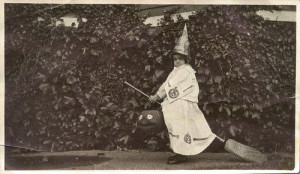No Child Left Inside

Photo by AP Wideworld Photos
“Every child,” wrote pioneer botanist Luther Burbank, “should have mud pies, grasshoppers, tadpoles, frogs, mud turtles, elderberries, wild strawberries, acorns, chestnuts, trees to climb. Brooks to wade, woodchucks, bats, bees, butterflies, various animals to pet, hayfields, pinecones, rocks to roll, snakes, huckleberries and hornets. And any child who has been deprived of these has been deprived of the best part of education.”
In our education-obsessed culture, elite kids play piano and speak three languages by the age of four, but just about every North American kid is deprived. In one of the greatest retreats ever, children are vanishing from a critical piece of territory: their own backyards.
And there isn’t a kid on the planet who knows what a huckleberry is, other than a character in a Mark Twain book.
For the average kid only spends 30 minutes a day outside, an amount that shrinks yearly. In this brave new world of Facebook and YouTube, Twitter and Google, iPod and Wii, kids are tuned in to technology, and kindergartners start school with 5,000 hours of TV under their belts.
Typical tweens put in a 40-hour week – a virtual full-time job – watching screens: TV, laptop, cell phone, and so on. They can name dozens of corporate logos and celebrities on sight – Lady Gaga! Justin Bieber! The cast from Glee! – but they cannot name three animals that live in their neighborhood, or three plants.
A first grader can sing every lyric of “Bad Romance,” God help us, but has no idea what a chickadee sounds like.
Adults are colluding in this retreat. Our school system has chained kids to their desks, number 2 pencils glued to their hands. If a kid is outside playing sports, it’s not a pickup game in the sandlot but a league organized by overzealous parents carpooling kids endlessly from one game to the next.
And the geographic world they wander is collapsing like a black hole into their laptops; the typical kid today roams a world only one-ninth the size a child of the ‘70s did. I wandered Long Island’s rapidly decreasing pine forests in the ‘60s, biking and hiking unthinkable distances, alone and with friends, with neither a cell phone nor a dime to make a call. Because inside our houses were the adults, and who wanted to be there? Every last child was outside, in the street, in the yard, on the corner, at the 7-Eleven.
But letting kids go into a forest alone today is unthinkable, heretical. Remember that kid who was allowed to take the train in New York alone? “Child abuse!” we screamed at his parents. Even my own kids, raised by me, a naturalist, have never been allowed to go unattended into a forest. I am always there: stranger danger, ticks and West Nile have all taken their toll, even on me.
This radical retreat from the great outdoors, now called “nature-deficit disorder,” a phrase coined by journalist Richard Louv in his groundbreaking book Last Child in the Woods, is the greatest health catastrophe facing Western kids.
Ever.
Asthma rates are climbing. Attention-deficit disorders are through the roof. Obesity rates skyrocket; diabetes, linked to weight, soaring. Kids who watch too much TV don’t physically move, change the working of their brains and even eat more poorly than other children; there is a distinct inverse relationship between TV use and the amount of vegetables in one’s diet. This next generation might not live as long as their parents.
At the same time, numerous studies indicate kids are physically and mentally healthier if they spend time outdoors and in nature. They calm down when surrounded by green, which seems to ameliorate their ADD. And free play outside lets children develop social skills they can’t get from tube-watching (or from playing sports under adult supervision), and their skills are more age-appropriate as well.
Here’s the kicker: Studies indicate that learning through nature-based programs helps kids score higher on standardized tests. Want your kid to go to Harvard? Have her study outdoors.
But change is blowing in the wind. Louv’s book, the first-ever environmental education bestseller, jump-started an international movement that gave birth to a web site, the Children and Nature Network. Places as disparate as nature centers and urban parks are unveiling natural playscapes: areas where kids can linger and climb rocks, play with sticks, push sand and gravel around, get muddy – do lots of delicious nothing. Nature preschools are becoming popular, too, as places where toddlers spend quality time outdoors. Even middle schools are developing nature-based curricula where the bulk of the student’s school day is given to studying the environment to integrate math, language and social studies into the real world.
In the United States, some 1,600 NGOs representing 50 million people have organized into a No Child Left Inside coalition, a spin on the Bush-era name for his education bill, lobbying Obama for statewide environmental literacy plans that include children spending quality time outdoors.
But it’s a long climb, for culture is the very air our children breathe, and culture conspires to convince kids that everything important can be found in that little box. We’ve seduced children indoors.
Now childhood itself is an endangered species. If we are going to save either the environment or our children, we have to take a surprisingly simple but very radical first step.
End the Great Green Retreat. Unplug our kids and kick them outside. To play. And hear chickadees. And find huckleberries.
In our education-obsessed culture, elite kids play piano and speak three languages by the age of four, but just about every North American kid is deprived. In one of the greatest retreats ever, children are vanishing from a critical piece of territory: their own backyards.
And there isn’t a kid on the planet who knows what a huckleberry is, other than a character in a Mark Twain book.
For the average kid only spends 30 minutes a day outside, an amount that shrinks yearly. In this brave new world of Facebook and YouTube, Twitter and Google, iPod and Wii, kids are tuned in to technology, and kindergartners start school with 5,000 hours of TV under their belts.
Typical tweens put in a 40-hour week – a virtual full-time job – watching screens: TV, laptop, cell phone, and so on. They can name dozens of corporate logos and celebrities on sight – Lady Gaga! Justin Bieber! The cast from Glee! – but they cannot name three animals that live in their neighborhood, or three plants.
A first grader can sing every lyric of “Bad Romance,” God help us, but has no idea what a chickadee sounds like.
Adults are colluding in this retreat. Our school system has chained kids to their desks, number 2 pencils glued to their hands. If a kid is outside playing sports, it’s not a pickup game in the sandlot but a league organized by overzealous parents carpooling kids endlessly from one game to the next.
And the geographic world they wander is collapsing like a black hole into their laptops; the typical kid today roams a world only one-ninth the size a child of the ‘70s did. I wandered Long Island’s rapidly decreasing pine forests in the ‘60s, biking and hiking unthinkable distances, alone and with friends, with neither a cell phone nor a dime to make a call. Because inside our houses were the adults, and who wanted to be there? Every last child was outside, in the street, in the yard, on the corner, at the 7-Eleven.
But letting kids go into a forest alone today is unthinkable, heretical. Remember that kid who was allowed to take the train in New York alone? “Child abuse!” we screamed at his parents. Even my own kids, raised by me, a naturalist, have never been allowed to go unattended into a forest. I am always there: stranger danger, ticks and West Nile have all taken their toll, even on me.
This radical retreat from the great outdoors, now called “nature-deficit disorder,” a phrase coined by journalist Richard Louv in his groundbreaking book Last Child in the Woods, is the greatest health catastrophe facing Western kids.
Ever.
Asthma rates are climbing. Attention-deficit disorders are through the roof. Obesity rates skyrocket; diabetes, linked to weight, soaring. Kids who watch too much TV don’t physically move, change the working of their brains and even eat more poorly than other children; there is a distinct inverse relationship between TV use and the amount of vegetables in one’s diet. This next generation might not live as long as their parents.
At the same time, numerous studies indicate kids are physically and mentally healthier if they spend time outdoors and in nature. They calm down when surrounded by green, which seems to ameliorate their ADD. And free play outside lets children develop social skills they can’t get from tube-watching (or from playing sports under adult supervision), and their skills are more age-appropriate as well.
Here’s the kicker: Studies indicate that learning through nature-based programs helps kids score higher on standardized tests. Want your kid to go to Harvard? Have her study outdoors.
But change is blowing in the wind. Louv’s book, the first-ever environmental education bestseller, jump-started an international movement that gave birth to a web site, the Children and Nature Network. Places as disparate as nature centers and urban parks are unveiling natural playscapes: areas where kids can linger and climb rocks, play with sticks, push sand and gravel around, get muddy – do lots of delicious nothing. Nature preschools are becoming popular, too, as places where toddlers spend quality time outdoors. Even middle schools are developing nature-based curricula where the bulk of the student’s school day is given to studying the environment to integrate math, language and social studies into the real world.
In the United States, some 1,600 NGOs representing 50 million people have organized into a No Child Left Inside coalition, a spin on the Bush-era name for his education bill, lobbying Obama for statewide environmental literacy plans that include children spending quality time outdoors.
But it’s a long climb, for culture is the very air our children breathe, and culture conspires to convince kids that everything important can be found in that little box. We’ve seduced children indoors.
Now childhood itself is an endangered species. If we are going to save either the environment or our children, we have to take a surprisingly simple but very radical first step.
End the Great Green Retreat. Unplug our kids and kick them outside. To play. And hear chickadees. And find huckleberries.
Writer-naturalist Mike Weilbacher directs a nature center near Philadelphia.






